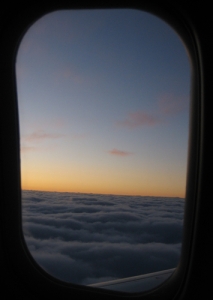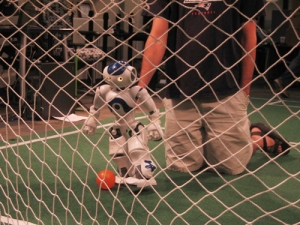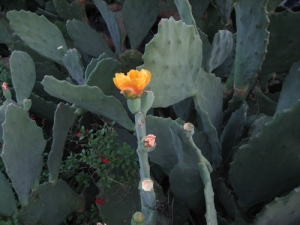So the conference was great. There isn’t much suspense to tell it now, but my flight was an hour late getting out on Friday from Baltimore, and since that’s exactly how much time I had to make my (airline-scheduled) connection in Memphis, I didn’t know if I was going to make it to Austin. The next flight wasn’t until 1 p.m. the next day, getting me in way after it would have been most useful to be there. Long story short, I made some friends under adversity (an Austin-goer from nearby University of Maryland College Park and a tattoo artist expat living in Amsterdam), we just made the connection, the connection was then itself more than two hours delayed, and I got to the hotel at 1 a.m. Only to get up at 6:15 for the pitching session sign-ups! But I wasn’t complaining (much) — I’d rather have had four hours of sleep than not be there at all.

The story pitches went well, along with a plenary speech by Dan Gillmor about capitalizing on change rather than panicking or doomsaying. I networked at the networking lunch. Actually, I networked like crazy all weekend. It wasn’t hard; everyone was there to do it. Freelancers looking for work, editors looking for writers, collaborators looking to meet or touch base in person. Some were competitive, most friendly, others pessimistic about the future of journalism, but nothing’s new there. I was surprised at how many people wanted to learn from me instead of the other way around. People really are interested in the skills and principles we learned at MIT and the sort of social- and multimedia work I’ve been doing for the NIH.
But in general, such a good time to see people such as Robin Lloyd again, unexpectedly meet other personal role models of mine like Robin Marantz Henig and Steve Mirsky, and generally talk with people who have either been in the business a while or who are also in the early stages and/or trying to negotiate the PIO/freelance worlds. (PIO = public information officer, the new term for public relations.) I ran into my RA from my freshman year of college, of all people. Embarrassingly, I had no idea who she was until she introduced herself. Other than that, I’m proud of myself. The introvert switch flipped so effectively that I couldn’t settle back down to my quiet old self for days afterward.
There followed afternoon sessions on social media and pitching science to non-science magazines. The latter was very useful for me, the former less so as someone who uses social media, but (a) it did get me on Twitter and (b) there were a few tips on differentiating social media bookmarking/rating sites that might help with my job.
Also a happy hour with MIT science writing alumni (there were maybe nine of us plus a professor) — hi, Artful Amoeba! — and a welcome reception at a bar in town with a live country band. The music was loud, but if nothing else it was great to be outside without a jacket at night when I’d just left 45 degrees and rainy.

More sessions and socializing on Sunday, beginning with a talk on new data-mining techniques for online journal databases and disease-related genes that I’m covering as part of my fellowship. There was also a talk on trying to quantify personality traits by studying people’s possessions and environments, but I was less impressed than I might have been had I not taken a course with Sherry Turkle, whose work is based on the idea that you can’t understand a person until you’ve spoken with them about what particular objects mean to them — what they’ve invested in the objects emotionally, and what relationships they have with others through those objects, that infuses the object with more meaning than anyone can figure out just by looking at it.
On Monday after listening to famous physicist Steven Weinberg give a primer about the Large Hadron Collider and the principle of symmetry, a group of us took a tour of some labs at the University of Texas. Highlights included:
- bubbling tanks of algae being grown in search of a cheap, electrically-based production method for biodiesel — everyone wanted to take pictures of that room;
- a lesson in the ways indoor air is more toxic than outdoor air;
- a truck that can shake the ground in three planes to test for faults, or check the ground strength at a particular time, or something related to earthquakes, anyway (it was impossible to hear the guy);
- vehicles equipped with computer-controlled actuators that serve as quick, energy-saving shock absorbers for armored vehicles on unpaved terrain;
- a supercomputer lab, or rather the display room for some of the supercomputers’ terminals; and
- robots! Soccer-playing robots, even. Apparently there is a Robot World Cup, and these foot-tall autonomous (not remote-controlled) Storm Trooper-looking androids and robo-puppies are learning to interpret video footage from their “eyes” to determine where they are on the field, where the ball is, where their teammates and opponents are, and how to score a goal. The one demonstrated for us had a case of gearthritis or somesuch and had to be propped up so it didn’t tip over when it tried to kick the little orange ball. But they were adorable and super-cool. As was the demonstration afterwards simulating automated traffic control with automated cars, barreling past each other in a ten-lane intersection in a way that would have human drivers screaming and covering their eyes.


That evening was the much-anticipated trip to see the bat colony. I have to say, from our vantage point in a little park at one foot of the bridge, the introductory speaker was more entertaining than the bats. (Although the speaker was actually quite entertaining. His lecture would have made a great Radio Lab monologue.) We couldn’t see them very well down there, the bats not-quite-silhouetted against the skyscrapers. We could hear them just fine, though.


And then I flew back Tuesday, returned to work Wednesday, and have been recovering ever since. I’ve got pages of notes here with actual tips and facts from the panels I attended — if anyone wants to see them instead of listening to anecdotes about my trip, I’m happy to share. There’ve been links going around at #sciwri09, too.






